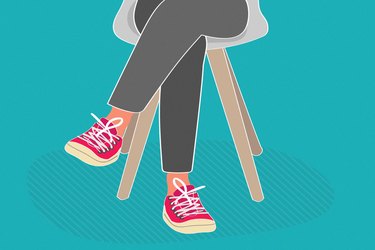
Unless you've been living under a rock (which can't be all that healthy, either), you've probably heard that sitting too much really isn't good for you — in fact, it's linked to an increased risk of dying from various chronic diseases, according to a June 2018 study in the American Journal of Epidemiology.
Yet one sitting position has been particularly maligned: Crossing one leg over the other has been blamed for everything from blood clots to high blood pressure to back problems. In fact, a 1999 campaign dubbed the Great American Cross-Out urged women to go 24 hours without assuming this position, pegging the posture to varicose veins and circulation issues.
Video of the Day
Video of the Day
But is it really as bad as all that? Here, we tease apart the facts from the myths.
Fact: It Can Cause Backaches
Many people find sitting in a chair with their legs crossed more comfortable than having both feet flat on the ground.
"Very few of us have perfect symmetry in the skeleton," says Georgia-based chiropractor Robert A. Hayden, DC, PhD, spokesperson for the American Chiropractic Association. "Some people have anatomic differences in leg length, for example, that may cause a tilt in the pelvis when standing." Placing one leg over the other helps counteract this imbalance.
But even though this position might feel good in the moment, it may exacerbate the problem later. Hayden explains that sitting with your legs crossed places asymmetric forces on the joints between the pelvis and the low back.
"There is cartilage in these weight-bearing joints that can swell when they are misaligned or irritated," he says, which may result in back pain.
Related Reading
Fact: It Might Lead to Bad Posture
Regularly overlapping your legs might cause you to tweak your body into an unnatural position.
A small November 2016 study of 30 adults in the Journal of Physical Therapy Science found that a one-leg-crossed sitting posture can cause scoliosis (sideways curvature of the spine), decreased trunk length and spinal deformities. "You may also notice a limp on the affected side," Hayden says.
Although you might not observe anything amiss in your stance at first, "poor posture has long-term consequences in the skeleton," Hayden says. "By the time you notice it, there may be damage or wear and tear that is difficult to overcome."
Fact: In Some Cases, It Increases Your Risk of Blood Clots
Here's a quick primer on how circulation works: "Oxygen-rich blood comes out of the heart and delivers oxygen to your body through the arteries, giving your muscles and brain energy," says Marc Bonaca, MD, director of vascular research and associate professor of medicine at the University of Colorado School of Medicine, and spokesperson for the American College of Cardiology.
"Circulation is important for optimal function, as well as preventing complications like heart disease and stroke," Dr. Bonaca adds.
When you cross your thighs, you obstruct some of the veins in your legs, slowing down blood flow.
"As a result, blood can pool in the veins, which may slightly increase your risk of blood clots in your legs," Dr. Bonaca says.
Related Reading
It's highly unlikely for the average person to develop a blood clot caused by overlapping legs alone, though. Still, he urges people to avoid sitting in this posture for longer than 10 to 15 minutes.
With that said, there are circumstances where your chances of crossing-induced clotting is significant. For one, if you have a risk factor for blood clots, it's important to keep both feet on the floor. According to the Centers for Disease Control and Prevention (CDC), these risk factors include:
- Cancer
- A family history of blood clots
- Recent hospitalization
Another hazardous situation? A long flight, where you're immobile for an extended period of time — especially if you're scrunched into an economy seat.
"You might bend the veins in your legs, which restricts blood flow and can cause venostasis, when blood pools in the veins," Dr. Bonaca says. "Crossing your legs will add even more constriction and increase your risk of clotting."
Tip
When you’re on a plane, get up and stretch your legs every 30 minutes. Calf exercises, which you can do either seated or standing, also promote circulation.
Finally, pregnant women should resist the urge to cross. During pregnancy, your blood clots more easily in order to reduce blood loss during labor and delivery, according to the CDC.
"Pregnant women also have restricted blood flow because the fetus sits on the inferior vena cava, a vein in your abdomen that goes back to the heart," Dr. Bonaca says. "Crossing your legs can worsen this constriction."
Fact: It Bumps Up Your Blood Pressure a Bit
If you were to take your blood pressure with one leg on top of the other, you'd find a slight uptick compared to keeping both feet on the ground.
"There is a transient increase in cardiac output related to constricted blood flow, but it is not a major problem unless you have high blood pressure or diabetes," Dr. Bonaca says. "Even if you do have a chronic condition, as long as it is controlled, it is unlikely that crossing your legs will have long-term harmful effects."
Dr. Bonaca points out that if you are monitoring your blood pressure at home, it's important to make sure your feet are flat on the floor for accurate results.
Fact: It Can Cause Pins and Needles
You might feel a tingling or numbness when you cross your legs, but it's nothing to worry about.
"This is due to peroneal nerve impingement and won't cause any damage," Dr. Bonaca says. "There is a slight possibility that after a sustained period of time you could develop a palsy or weakness, but that is very unlikely."
Myth: It Will Give You Varicose Veins
According to the National Heart, Lung, and Blood Institute, the following contributors increase your chances of developing raised, swollen, twisted veins (aka varicose veins):
- Advanced age
- Standing for long periods of time
- A sedentary lifestyle
- Obesity
- A family history of varicose veins
- Pregnancy or childbirth
One thing that doesn't matter? Whether or not you cross your stems.

A Better Way to Sit
In an ideal world, you would sit like Queen Elizabeth: Legs uncrossed, feet flat on the floor, back straight, eyes focused straight ahead.
Adjust your chair so that your knees are at a right angle (use a footstool if necessary). "I encourage patients to arrange their work station with this position in mind," Hayden says. "Place your computer monitor, phone, mouse and other equipment to optimize comfort and good posture."
If the habit of crossing your legs is so ingrained that you find it uncomfortable to sit otherwise, Hayden encourages people to at least switch legs frequently.
"If you're concerned about swelling, elevate your legs using a foot rest or small box," Dr. Bonaca says. "Graduated compression stockings that stretch to the knee can increase comfort, too."
You might also want to try a stability ball chair. "These are essentially inflated exercise balls on frames — you sit on air, so the postural muscles in your back are fully engaged to keep you from slumping," says Hayden, who uses them for his office staff. "It takes a bit of acclimation, but it is comfortable in time and prevents back pain with long periods of sitting."
Dr. Bonaca also likes standing desks or walking desks.
And be sure to not stay seated for too long. The Mayo Clinic suggests taking breaks to move around every 30 minutes. "Walking engages your calf muscles, which gets your blood pumping," Dr. Bonaca says.
Related Reading
Get Your Posture Back on Track
If you have developed back pain or poor posture as a result of crossing your legs, see a chiropractor or physical therapist. Spinal adjustments, stretches and targeted exercises can help reverse these issues.
"In addition, heel lifts or custom orthotics can address leg length differences and balance the pelvis to prevent recurrence of the problem," Hayden adds.
So, How Bad Is It Really to Sit With Your Legs Crossed?
While crossing your legs is unlikely to cause serious complications (assuming you're not in a high-risk category), it can wreak havoc on your back. Since there are so many better ways to sit, why not try one of them instead?
Related Reading
- Journal of Physical Therapy Science: "The effects of sitting with the right leg crossed on the trunk length and pelvic torsion of healthy individuals"
- Mayo Clinic: "What are the risks of sitting too much?"
- American Journal of Epidemiology: "Prolonged Leisure Time Spent Sitting in Relation to Cause-Specific Mortality in a Large US Cohort"
- Never Shower in a Thunderstorm: Surprising Facts and Misleading Myths About Our Health and the World We Live in
- Centers for Disease Control and Prevention: "Are You at Risk for Clots?"
- Centers for Disease Control and Prevention: "Pregnant? Don't Overlook Blood Clots"
- National Heart, Lung, and Blood Institute: "Varicose Veins"
- Cleveland Clinic: "Back Health and Posture"
Is this an emergency? If you are experiencing serious medical symptoms, please see the National Library of Medicine’s list of signs you need emergency medical attention or call 911.
